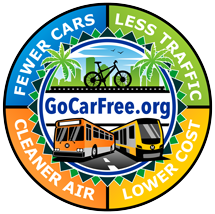
Lesson 13
Mankind’s Greatest Invention: Bicycling for Transportation
“Every time I see an adult on a bicycle, I no longer despair for the human race.”
– H.G. Wells

Wouldn’t it be great if someone invented a form of personal transportation that:
- Is practically free
- Is immediately available on demand
- Went where we wanted to go whenever we wanted to go there
- Didn’t require any licensing, taxes, stickers, or fees
- Could travel faster than cars stuck in traffic
- Was safer than driving a car; didn’t pollute the environment
- Helped us get exercise while we’re using it
- Made our bodies look better; didn’t make us pay for parking
- Didn’t force us pay high gas prices
- Helped boost our self-confidence, have more fun, and
- Improved our outlook on life?
Gosh, that would be great. Now go ride a bicycle.
If you’re in a hurry and don’t have time to read this entire lesson, just watch or listen to the video below. It’s by influencer Heather Nicholds. She explains in detail why she loves bicycle commuting, and then she gives her tips and tricks for successful commuting and gear.
FACTS
In England, listeners to BBC Radio were asked to vote in an online poll for the most significant invention since the year 1800. The overwhelming winner was the bicycle, with 59 percent of the vote. The transistor came in second with 8 percent.
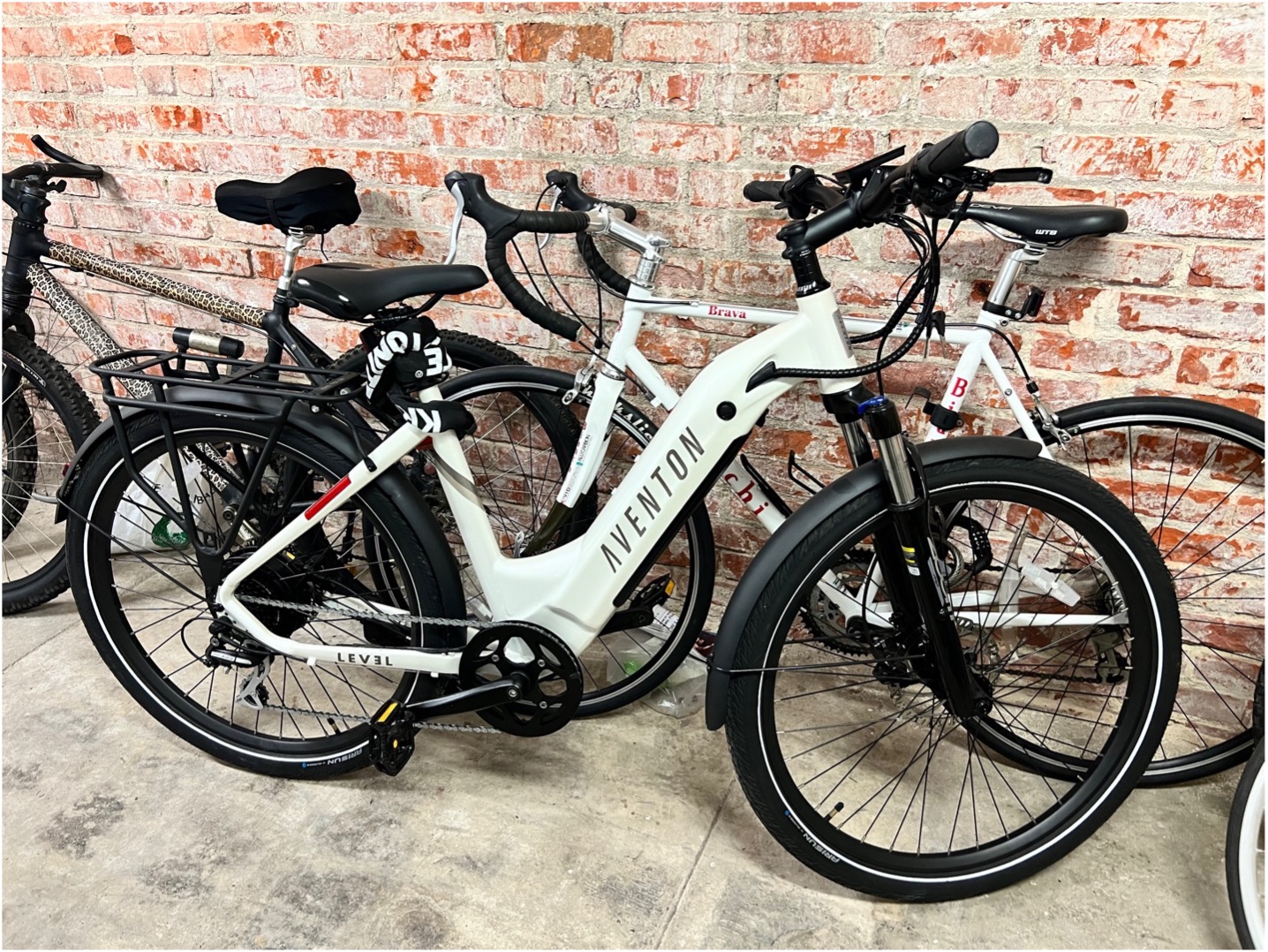
The E-bike Revolution
The biggest advancement in bicycle technology in the last century is the proliferation of battery powered e-bikes. There are now dozens if not hundreds of e-bike manufacturers making incredible bikes of all sizes, shapes and designs. E-bikes can help bicycle commuters travel further, go faster, conquer hills with ease, arrive less sweaty, and have more fun than regular pedal bikes.
The technology, form, and function of E-bikes are so good they have truly revolutionized bicycles as a mode of transportation. In Europe and Asia bicycles have always been seen as tools, not toys. But in American culture, bikes largely have been considered recreational. Not any more, thanks to e-bikes.
E-bikes make hauling children, carrying cargo, going grocery shopping, running errands, and bicycle commuting much faster, easier, and more fun. As a result, e-bikes have transformed car free living by also making it so much easier.
Below is a video from the eBiketips YouTube channel. It’s titled, “Could you ditch the car? 5 tips for going car-free.” I agree with his premise, which is that e-bikes can replace 95 percent of what cars can do – and for the other 5% you can rent a car or use car sharing.
The Benefits of Bicycle Commuting
The bicycle is the most efficient mode of human transport ever devised. The only form of transportation that’s cheaper is walking. And if you factor in that biking saves time by covering more ground more quickly, walking may not even be cheaper.
There are so many benefits to commuting by bicycle, we can’t possibly list them all in this lesson. So here is the highlight reel of why you should consider commuting on a bicycle or e-bike.
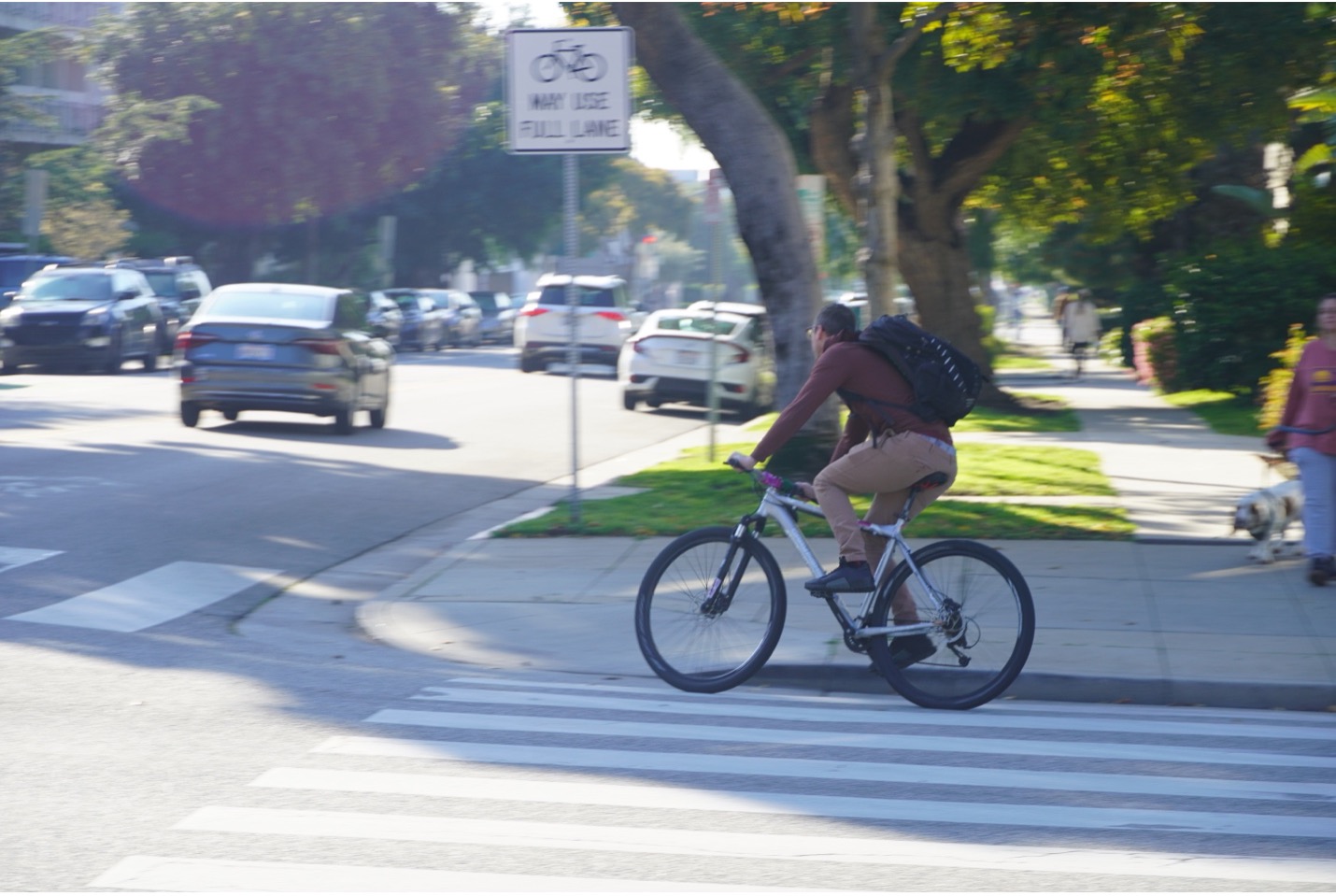
It Saves Money
When you commute by bicycle you have no monthly car payment, no gas to buy, no parking to pay for, no oil changes, no car washes, no finance charges, no insurance premiums, no license or registration fees, no personal property taxes… and the list goes on.
You may spend a paltry $200 or so per year on maintenance and equipment for a bike, but even that is offset by other savings. For example, when you get your daily exercise by riding to work, you may cancel your gym membership.
Plus, the cost of entry into the world of bicycle commuting is low. There’s no need to spend $1,000 on a fancy road bike, or a few thousand on an e-bike. Not yet, anyway.
You can buy a decent used bicycle for around $150. Add another $50 for a safety check and tune-up at your local bike shop, plus $100 for a good (new) helmet and $50 for a sturdy lock. For about $350 you are ready to get out and ride.
Now compare that to the $8,000 the average American spends every year to own and operate a car. Trading your car for a bicycle may literally be your ticket to easy street, in more ways than one.
Car Free Success Story:
I’ve saved thousands upon thousands of dollars because of bicycle commuting. My retirement account is flush with those savings. I’ll be able to do a whole lotta’ biking in my retirement!
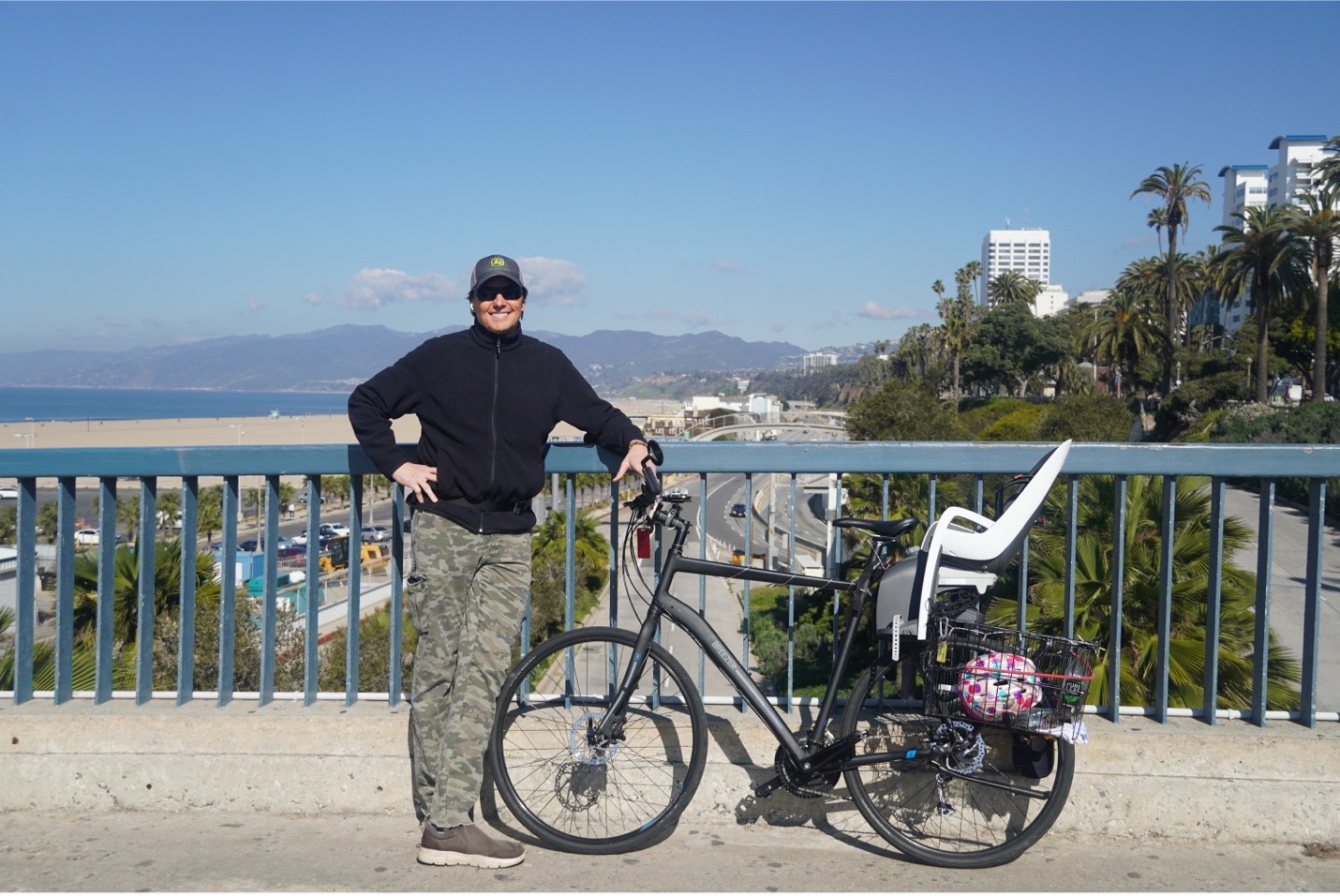
GoCarFree.org Executive Director Chris Balish in Santa Monica.
It Will Make You Healthier
If you commute to work in a car every day, you have two choices. You can either sacrifice an additional hour of your free time to fit in a daily workout, or you can just accept being overweight, out of shape, and unhealthy.
According to the American Medical Association, 60 percent of Americans lead completely sedentary lifestyles. And as you know, lack of exercise can lead to heart disease, diabetes, and many other health problems.
Bicycle commuting is a guaranteed way to get moderate physical activity five days a week. Cycling burns about five hundred calories per hour. It exercises your heart, lungs, and muscles. It tones and firm arms, legs, shoulders, abs, and buttocks. It burns fat and increases metabolism.
It helps you lose weight without dieting. It builds your immune system and makes you less likely to get sick. It reduces the risk of heart attack and stroke.
And it’s considered low-impact exercise, so you won’t damage your knees or other joints. It may even help you live longer. Plus, you’re exercising while you’re commuting, which saves time.
So why sit on your butt in rush-hour traffic, clogging your arteries with fast food and watching your waistline expand, when you could be losing weight, getting in shape, and building a healthier body? All this while saving a ton of cash.
Emotional Wellbeing
What about mental health? Does bicycle commuting have any benefits when it comes to emotional wellbeing? In the video below, YouTuber Broadway Biker talks about the emotional benefits of bicycle commuting.
Car Free Success Story:
I hate to think that some overweight people, elderly, or people with kids think they can’t ride a bike or walk for transportation. Once they start doing it, it just gets easier, like yoga or anything else. Then they get the accruing returns of increased energy, better joint health and bone density, less depression, etc.

You’ll Avoid Traffic Jams
Even the fastest cars slow to a crawl when they get caught in a traffic jam. Some studies show the average speed of a car in city traffic is less than fifteen miles per hour.
Bicycle commuters, on the other hand, never sit in bumper-to-bumper traffic. If there’s an accident, they can ride around it on the sidewalk, bike lane, or wide shoulder. If a road is shut down for construction, they can cut through a city park or take a bike path. With an average speed of ten to twenty miles per hour, an experienced cyclist can make a five-mile commute in fifteen to thirty minutes.
Car Free Success Story:
I finally got up the courage to buy a bicycle and start commuting to school. It was scary at first. I wasn’t in shape at all. And I didn’t have anyone to get good advice from, so now I see how many mistakes I made (just a small example: no fenders in Portland!). Still, every day it got easier, and every day I liked my trip more and more.
As time went by, I began to notice all kinds of other benefits. I started to feel stronger, and proud of my strong body. I started to really know the city I lived in, and be able to get all kinds of places on my own. I noticed that I was in a better mood all the time, and I was sleeping better. I felt independent and able to take charge of when and how I got somewhere. And I use the money I would have spent on a car to take a big trip every year. In the last few years alone I’ve been to India, Switzerland, Italy, Spain, France, and South Africa.
It Helps Communities and the Environment
According to a study by the U.S. Department of Transportation, “Bicycling and walking conserve roadway and residential space; avert the need to build, service, and dispose of autos; and spare users of public space the noise, speed, and intimidation that often characterize motor vehicle use, particularly in urban areas.”
Cycling helps the environment by reducing the use of fossil fuels for transportation. Bicycle riding does not contribute to smog, air pollution, global warming, or other environmental damage caused by locating, extracting, transporting, processing, and burning petroleum. Every time a cyclist makes a four-mile round-trip commute on a bicycle instead of driving a car, she prevents fifteen pounds of toxic tailpipe emissions from polluting the air.
When a bicycle replaces a car for daily transportation, we all breathe less carbon monoxide, lead, cyanide, benzene, sulfates, ozone, particulate matter, and volatile organic compounds.
Car Free Success Story:
I’m fifty-eight years old and I use a mountain bike for commuting and there’s absolutely nothing that can stop me from getting to work. I love to be outside, and there’s no downside to this. It’s great just ignoring the worst traffic jams.

It’s Fun and Empowering
The majority of bicycles sold in this country are used for recreation. That’s because riding a bike is inherently fun. You feel the sun on your face and the breeze in your hair, and you can smell the trees and flowers. You can greet fellow cyclists and pedestrians verbally as you pass by or wait at a red light. Try doing that in a car.
Bicycle commuting is a great way to start the day invigorated. You’ll arrive at work refreshed, alert, and full of energy and endorphins. It’s also an effective way to relax after work, guaranteed time to exercise away the day’s stress. You may even find yourself extending your ride to maximize your time in the seat.
Commuting under your own power will boost your self-esteem and self-confidence. Many bike commuters report a feeling of accomplishment, empowerment, and self-reliance. In contrast, car commuters often complain of feeling powerless sitting in traffic and helpless at the gas pump as prices rise.
Choosing a Bike
Do not go out and buy a brand new $3,000 e-bike rigged out with the best commuting gear money can buy. Don’t even buy a $500 bike. Because at this point, you don’t know what type of bike you need, or even if bicycle commuting is something you’ll enjoy.
If you already own a bicycle, use it, provided it’s safe, functional, and relatively suited to the purpose. If you don’t have a bike, borrow one. If you can’t borrow one, buy a used bike for a fraction of the cost of a new one.
If you decide later that bicycle commuting is something you definitely want to do, then go spend as much money as you want. Another advantage of buying a quality used bike is that if it gets stolen you’re not out all that much money. I still commute on the same secondhand bike I paid $150 for nearly three years ago.
Whatever bike you use for the initial trial period, be sure to have an experienced bike mechanic perform a complete safety check before riding it in traffic. Also, make sure the bike is adjusted to your height and body size. While you’re at the local bike shop, buy a quality (brand-new) bicycle helmet, and ask the staff to help you adjust it properly.
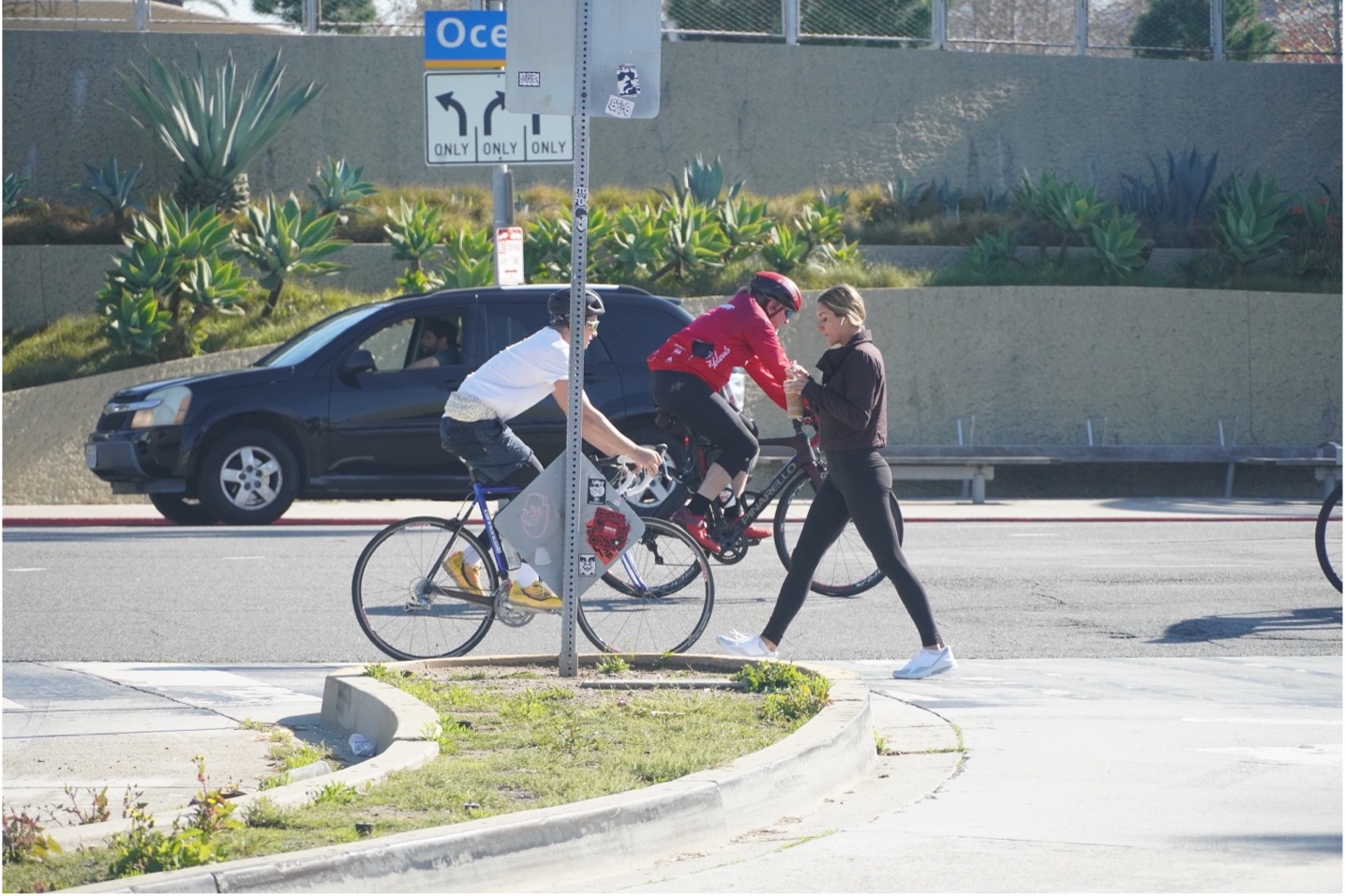
Choosing Your Route
The next step is finding the best route for your bicycle commute. Note that I did not write “finding the fastest route.” There’s a big difference.
When cycling, safety is the number-one concern. If there’s a street that runs straight from your home to your office, great. But if that street is poorly lit and filled with speeding cars, has narrow shoulders and broken pavement, and is covered in gravel, then you want to avoid it.
In every city or town, some streets are more suitable for automobile travel, others more suitable for bicycle travel. Often the two are just a block away from each other. Here are a few of the differentiators to look for:
- A designated bike path or wide shoulder
- Smooth, even pavement
- Street lights
- Scenic views and tree-lined streets
- Lighter traffic pattern
- Sidewalks
- Proximity to services (like a neighborhood coffee shop)
Things to avoid:
- Roads with heavy traffic
- Roads with fast-moving traffic
- Dangerous intersections
- Poorly lighted areas
- Steep hills
- Potholes or broken pavement
- Sand and gravel on the roadway
- Dangerous drain grates or gutters
- Railroad tracks
- Rumble strips and speed bumps
- Loud traffic noise
- Truck routes
- Narrow bridges or tunnels
Ultimately, you should try to come up with three or four different routes that suit you. You may choose one route on a gorgeous summer day, a different route on a rainy day, and yet another route in the winter when it gets dark earlier.
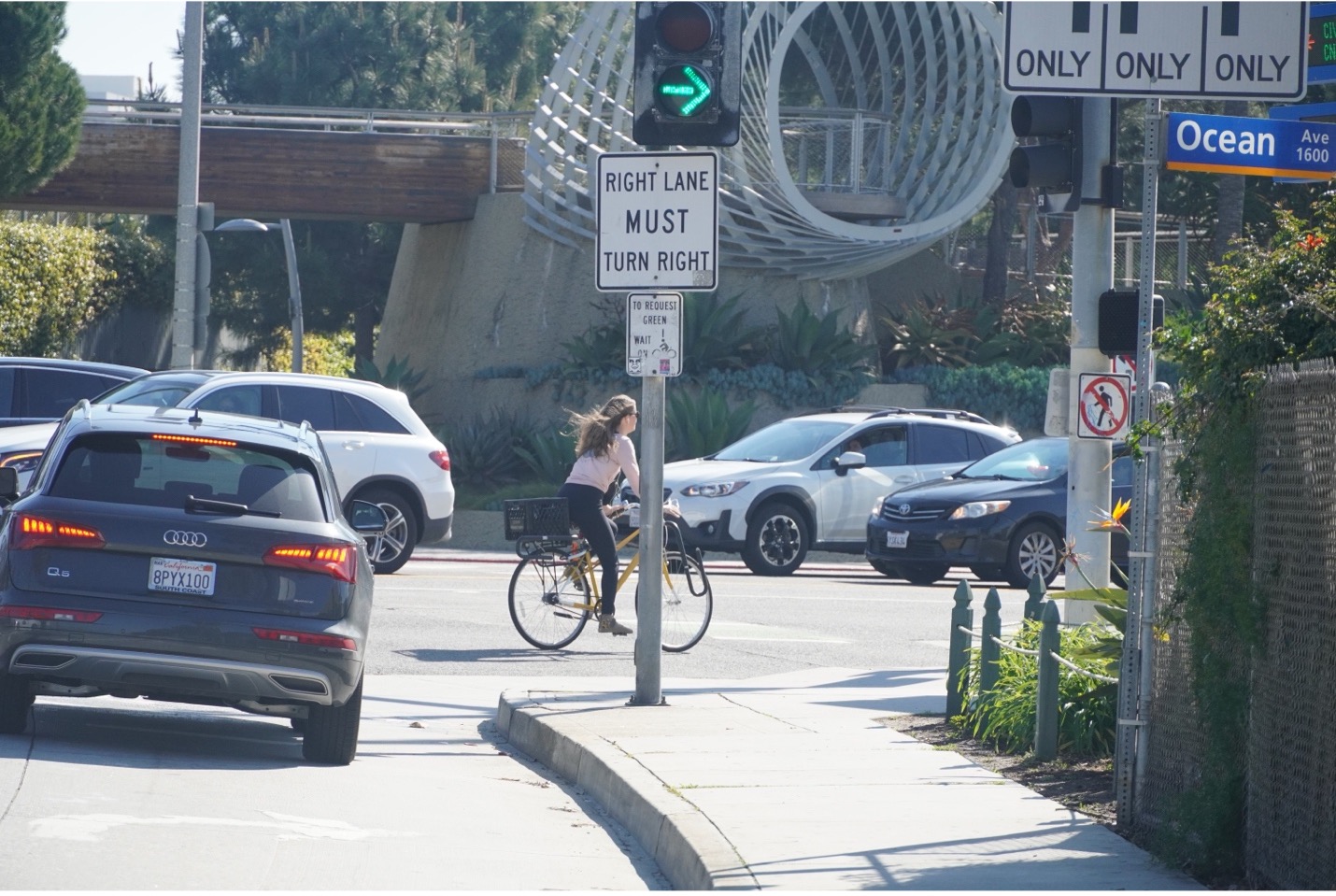
Car Free Success Story:
It takes me about the same time to commute by bike as it does my coworkers who drive in from the same area, and I’m getting physical activity. When there is heavy traffic, I beat everyone. People always think I look very nice for someone who just got off her bike. They can’t believe I bicycled in a suit or in a skirt (which, having traveled to countries where this is normal, I certainly don’t think it is amazing). Most people are impressed. They tell me they wish they lived close enough to bike to work.
How Far Can You Go?
Comfortable bicycle commuting distances vary widely by individual fitness level, topography, and personal preference. Some dedicated cyclists ride fifteen miles or more each way. But for the average commuter, three miles or less each way would be considered an easy ride. Six miles is a substantial but very doable ride. And ten miles or more might require some physical training. According to the National Survey of Pedestrians and Bicyclists conducted by the U.S. Department of Transportation, the average length of a bicycle trip is 3.9 miles.
Car Free Success Story:
I’ve been car free since 1997. Once you figure out a system, the challenges of living car free are few. Occasionally I need a vehicle for trips to Home Depot or for moving, and I can ask a friend or rent a vehicle for those occasions.
The lifestyle benefits of living car free are great. I know that if I had a car I would not be in as good of shape. Emotionally, biking is a cure for the blues and for stress. It’s also a boost for the ego to zip by cars stuck in rush hour on city streets. I never get road rage.
The financial benefits of living car free are wonderful. I do not have to pay car payments, insurance, parking, tickets, towing fees, city stickers, or major repairs. I can’t imagine how much money I’ve saved by not owning a car.
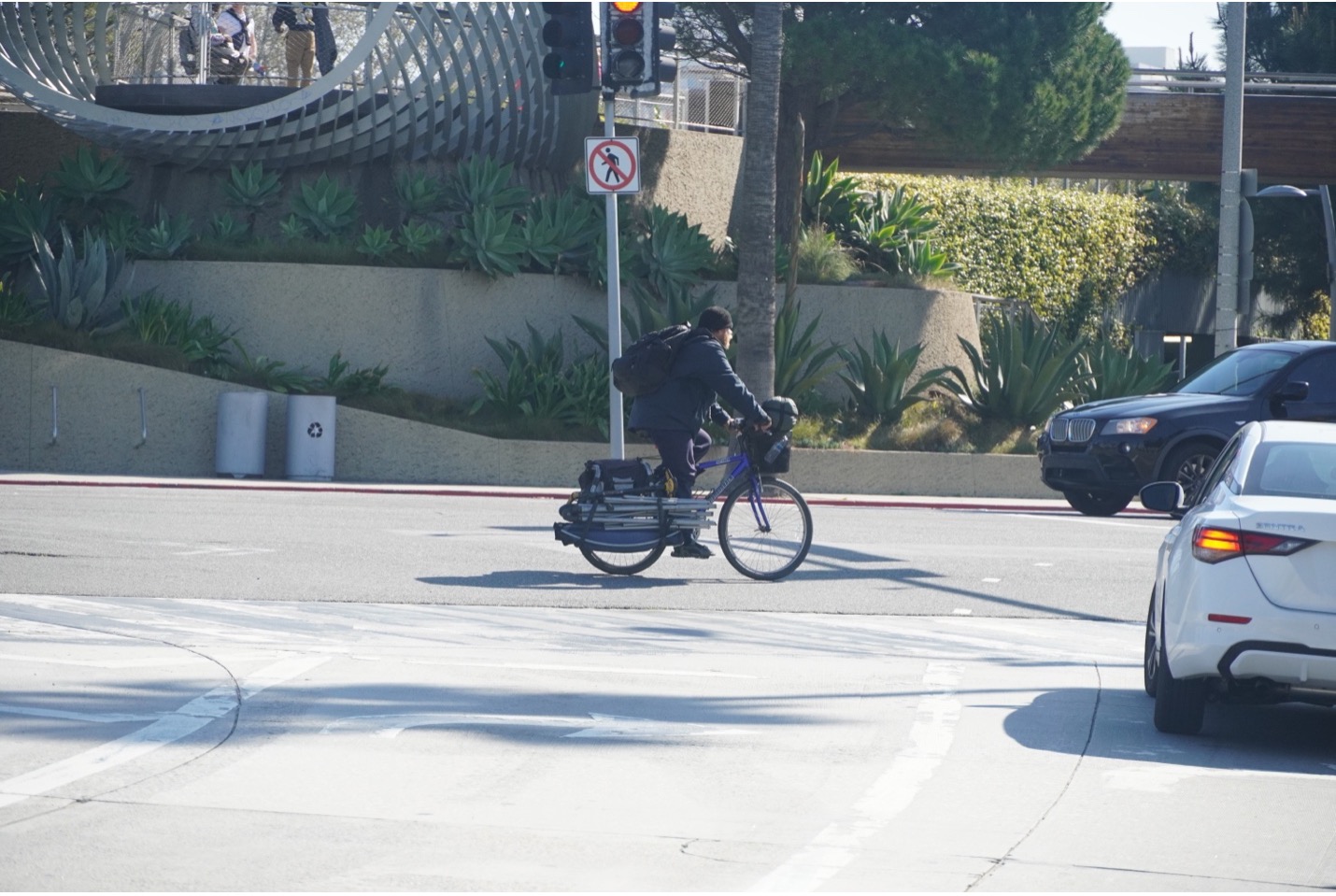
Carrying Cargo
If you ride to work you may need to carry papers, a notebook computer, lunch, a change of clothes, and so on. Or perhaps you have to run a few errands after work, like a trip to the supermarket or video store. The simplest and easiest way to do this is to use a small backpack. Always keep a few folded plastic garbage bags in the bottom of the backpack so you can keep your stuff dry if it begins to rain.
If you become a serious bicycle commuter you can rig your bike with panniers (saddle bags), baskets, and racks for carrying loads off of your body. There are dozens of excellent cycling gear companies that cater to commuters and touring cyclists. You can even buy folding garment bags designed to carry a business suit on your bike without wrinkling.
Car Free Success Story:
I highly recommend using panniers (saddle bags). They make your bike wider and also provide more surface area to put on reflectors or reflective tape. I have noticed drivers give me more room than if I didn’t have them on. Plus you can carry extra clothes in case the temperature changes. I also use them to carry stuff for errands or shopping.

Storing Your Bike at Work
With a little creativity this problem is easy to solve. If your bike will fit in a corner of your office, you’re golden. If not, ask the property manager to install bike hooks in the ceiling or on the wall to hang your bike.
If that fails, ask the custodial staff in your building if there’s a utility closet, storage room, or workout facility that has extra space. I’ve found most housekeeping and custodial workers to be very helpful in this regard, since they know the nooks and crannies of the building better than anyone. A smile and a sincere “thank you” are usually all it takes to get their help.
If your office building does not allow bicycles inside at all, write the management company and ask for special permission. Tell them it’s your only mode of transportation.
If you don’t know whether your building allows bikes, don’t ask! Just bring it in and assume it’s alright. Chances are no one will ever question you. But if you ask first, there’s a chance you’ll be denied.
If there’s no way to store your bike inside your building, look for a covered parking garage where you can lock your bike securely. If there are plenty of parking spots for cars but no bike racks, take action. Write a letter asking that one parking spot be converted to bike parking.
Try to park your bike where there are other people around, instead of in an out-of-the-way place. If someone is going to cut through your lock, they’re unlikely to do it where others are watching. Many experienced urban riders suggest using both a rigid U-shaped lock and a chain or cable lock. Double locking will deter most thieves.
Where I live in Los Angeles County, thieves will sometimes try to steal your bicycle seat. I have no idea why they would do this. But I found a solution. I bought a bicycle seat with a ventilation hole in the middle, then I bought a thick hardened chain and padlock to secure the seat to the bike frame. I dare any creep to try to steal it. Good luck with that!
Riding Safely
The most important part of bicycle commuting is safety. There are many excellent resources and courses available that teach safe cycling. Here are some of the basics:
- See and be seen. Wear bright-colored clothing and reflectors so motorists will spot you. If you wear a backpack, cover it with reflective tape and clip a red strobe light to the back. Wear reflective leg bands around your ankles; motorists will see the up-and-down motion and immediately know you’re a cyclist. Use a headlight and taillight at night. And make sure you can see the road and other drivers, especially when you’re bundled up in the winter or in the rain. Always look behind you when changing lanes; a rear-view mirror helps with this.

- Always wear a helmet. Wearing a helmet reduces your chances of a head injury by 85 percent. Ask your local bike shop to help you size and adjust the helmet properly. Never buy a used helmet.
- Obey the rules of the road. Bicycles are considered vehicles and should follow the same traffic laws that apply to cars. That means stopping at red lights and stop signs. Check with your state for other laws that apply to bicyclists.
- Ride with traffic. Do not ride against oncoming traffic. There are too many reasons for this to list here.
- Ride on the right. All fifty states require slow-moving vehicles, like bicycles, to ride on the right. Motorists expect slower vehicles on the right.
Ride as far right as safely practicable.
EXCEPT when passing others or turning left;
EXCEPT to avoid parked cars, moving vehicles, or people;
EXCEPT to avoid animals, objects, surface debris, or other hazards;
EXCEPT in a vehicle lane too narrow for a bicycle and another vehicle to pass safely, side by side, within the lane.
From The Art and Science of Advanced Traffic Bicycling by Lauren Cooper
Be predictable. When you follow the same rules as everyone else, your behavior is predictable. When you’re on your own game plan or making up rules as you go, motorists get confused. Confusion can lead to accidents.
- Communicate. Always signal your lane changes and turns to let other drivers know where you’re going. Assume they do not see you until you’re certain they do.
- Beware of parked cars. Always ride at least three feet from parked cars so you don’t get hit by an opening door. This is the most common cause of injuries to cyclists.
- Ride in a straight line. Do not swerve in and out of the roadway or between parked cars.
- Always ride defensively. Watch for cars that are driving erratically. Try to avoid other drivers’ blind spots. Be ready to take evasive maneuvers when needed.
- Avoid road hazards. Wide sewer grates, oil slicks, sand, gravel, utility hole covers, and debris in the roadway can cause you to become more intimately acquainted with the pavement than you would like.
- Do a quick check before every ride. Make sure your tires are properly inflated. Make sure your brakes are working. And check your chain, gears, and quick-release levers to make sure they’re in order.
Keep in mind the following statistics from the website BicycleSource.com:
- Half of all bicycle-car collisions happen at intersections.
- Bicycling against the flow of traffic accounts for about 16 percent of collisions.
- Only 5 percent of collisions involved a cyclist being hit from behind.
One of the best articles I’ve ever seen on bicycle safety appears on the website BicycleSafe.com. The author is Michael Bluejay, and the article is “How to Not Get Hit by Cars.” Please read this before riding in city traffic. Also, the League of American Bicyclists offers a number of safe riding courses, including one on commuting. Check out their website at bikeleague.org.
Further Reading
- Effective Cycling by John Forester
- Urban Bikers’ Tricks and Tips by Dave Glowacz
- The Art of Urban Cycling: Lessons from the Street by Robert Hurst
- The League Guide to Safe and Effective Cycling by The League of American Bicyclists
- Anybody’s Bike Course by Tom Cuthbertson
Dressing for the Weather
How you dress will be determined by how long your commute is and by weather conditions. If you live within three miles of your workplace and you don’t have to climb any steep hills, you’ll probably be fine wearing your work clothes while you ride.
Even in the middle of summer temperatures at 8:00 a.m. are cool enough in most regions that you won’t be covered in sweat by the time you arrive at the office. Remember, too, that when you’re riding a bike the wind rushing over you quickly evaporates sweat off your skin. This helps you to stay dry and lowers your body temperature.
If you have a longer commute, or if you live in a hot or humid climate, wear comfortable pants and a T-shirt during your ride, then change into work clothes when you get to the office. Be sure to bring dry socks and underwear. We’ll cover wardrobe, appearance, and grooming tips in greater detail in lesson 15.
Rain is not a problem for a well-equipped bicycle commuter. I’ve seen bicycle commuters wear everything from thin ponchos to rubber rain slickers to full Gore-Tex suits. More than likely, a cheap nylon rain suit will work just fine. Front and rear fenders on your bike will also help keep water from spraying up onto you.
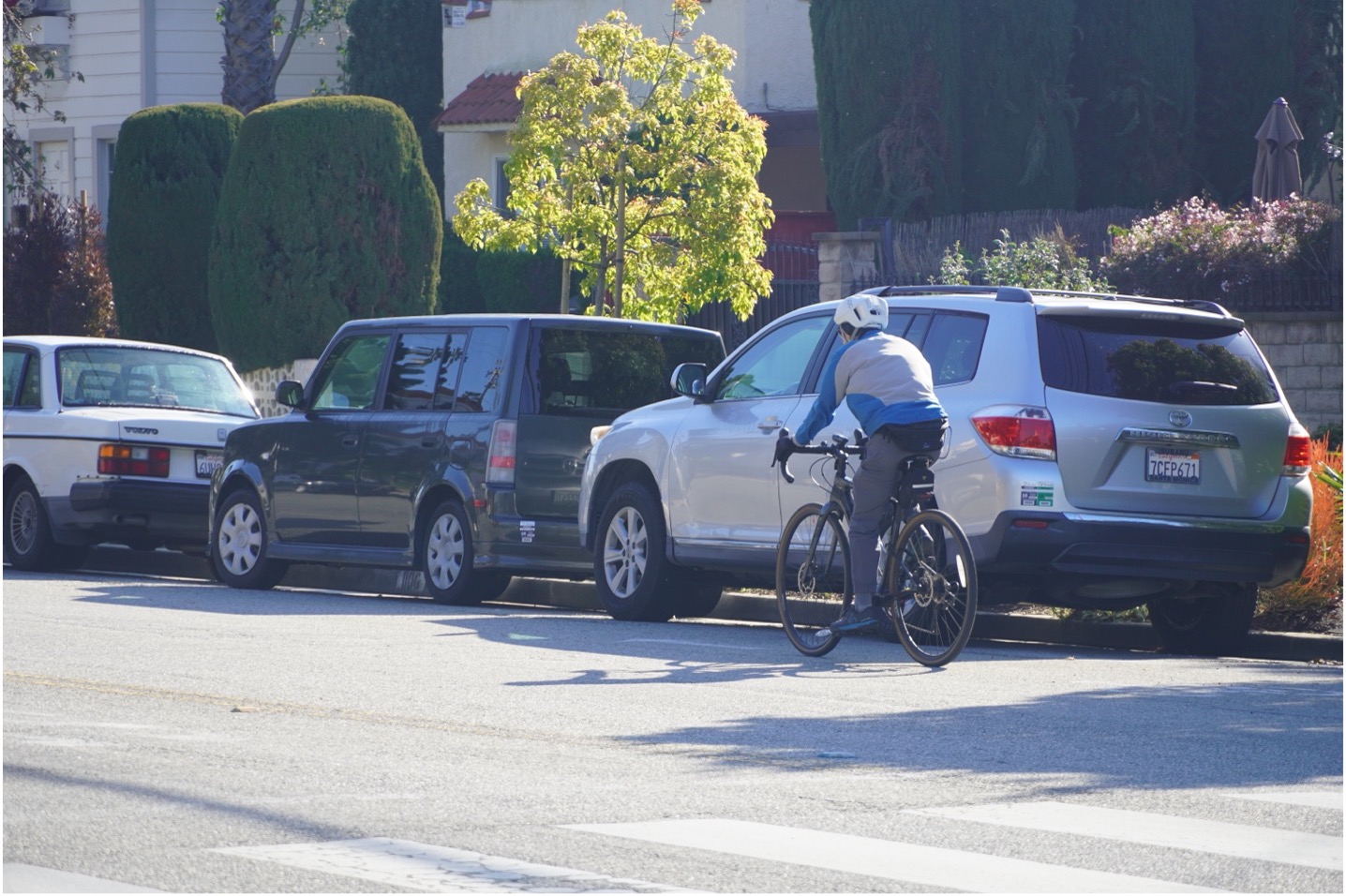
Cycling in Winter
Clothing for winter cycling is similar to what you’d wear to go snow skiing or hiking in the cold. Dress in layers so you can easily shed clothing when your body temperature rises. And your body temperature will rise, so start the ride a little underdressed.
Make sure your outer layer is windproof. Winter gloves, a neck gaiter, earmuffs, and even a partial facemask may be in order, depending on the temperature.
Some bicycle commuters wear ski goggles to protect their eyes from harsh winter winds. Whatever you wear, be sure you have complete visibility and an unobstructed view of the road and the cars around you.
Winter precipitation can be tricky, but not impossible to handle. If you have knobby tires you can probably ride in the snow. But when there’s ice on the road, it’s time to call a cab or take the bus.
If you live in a climate that regularly gets severe winter weather, visit IceBike.org, a website dedicated to bicycling on snow and ice.

Bike with a Friend
Commuting by bicycle is fun, but it can be even more fun when you get other people involved. Maybe you have a coworker who lives near you or a neighbor who works in the same office building. If you cycle together you can share experiences from the road, swap tips and strategies, and explore new routes.
Plus, riding in a group is safer. You could even check with your local bike shop or cycling club to see if you can find a bicycle commuting veteran to be your mentor.
Get Ready to Get Healthy
Bicycle commuting for the first time is like starting a new daily exercise routine. If you’re already in good physical condition, you should have no problem.
But if you’ve been behind a car steering wheel for so long that your pants no longer fit, you better see a doctor first. Getting a complete physical is a hassle, but it’s a worthwhile precaution.
Unless you’re an avid weekend cyclist, you may be sore for the first week or so of riding to work. Don’t be discouraged. Soreness is a sign that your muscles are growing and getting stronger. Soon that soreness will disappear – along with your love handles!
Car Free Success Story:
I think people think it’s attractive — a young woman riding a bike in traffic — it’s daring, strong, self-possessed.
Conquer Your Fears Gradually
Commuting through traffic on a bicycle is a scary concept for some people. If you’re apprehensive, don’t rush into it. The best way to conquer your fear is to gradually build your cycling skills and your confidence.
Start by riding around your neighborhood in the evenings. When you’re comfortable with that, move up to cycling along larger streets on the weekends.
Eventually you’ll have the confidence and skill to handle yourself on a busy thoroughfare at the height of rush hour. Experienced cyclists recommend riding every day to keep skills sharp.
I guarantee if you stick to the advice in this lesson, soon your bicycle commute will be the highlight of your day.

